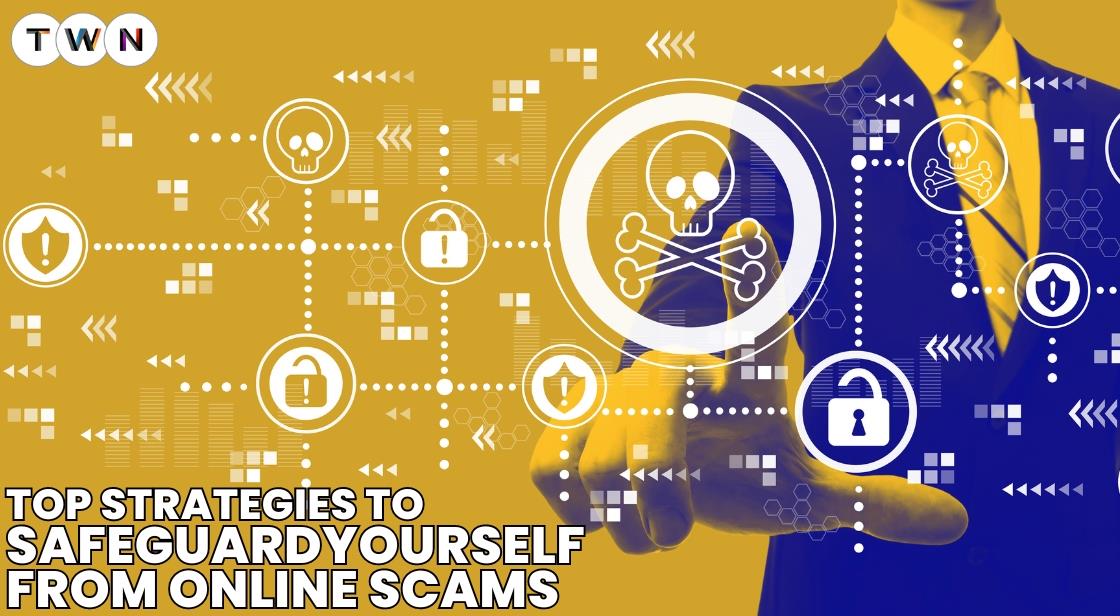Top Strategies to Safeguard Yourself from Online Scams

Blog Post
In today's digital age, online fraud has become an increasingly prevalent and sophisticated threat, targeting individuals and businesses alike. As we navigate through a landscape brimming with online transactions and interactions, the risk of falling victim to scams, phishing attempts, and other fraudulent activities has never been higher.
Online fraud encompasses a wide range of deceptive practices designed to trick users into disclosing sensitive information or making financial transfers under false pretenses.
The rapid advancement of technology and the widespread use of the internet have provided fraudsters with ample opportunities to exploit vulnerabilities, making it essential for everyone to understand how to protect themselves effectively.
With the growing concern surrounding online fraud, it is crucial to adopt proactive measures to safeguard personal and financial information. From using strong, unique passwords and enabling two-factor authentication to being cautious with emails and links, each step plays a vital role in enhancing your online security.
Additionally, staying informed about common scams and reporting suspicious activity can further protect you and others from potential threats. This blog provides essential tips and strategies to help you navigate the complexities of online security, ensuring that you remain vigilant and well-prepared against the ever-evolving landscape of online fraud.
How to Protect Yourself from Online Fraud: Essential Tips
What is Online Fraud?
Online fraud involves various deceptive practices carried out over the internet to trick individuals or organizations into disclosing personal, financial, or sensitive information. Common forms of online fraud include phishing emails, fraudulent websites, identity theft, and online scams. The perpetrators use sophisticated techniques to impersonate legitimate entities, often leveraging social engineering to manipulate their targets into revealing confidential information.
Why It’s a Growing Concern
The rise of online fraud is closely tied to the increasing amount of time people spend online and the growth of digital transactions. As more personal and financial information is shared online, fraudsters have more opportunities to exploit vulnerabilities.
Advances in technology also enable more sophisticated fraud tactics, making it harder for individuals to detect and protect themselves from such threats. The anonymity of the internet allows scammers to operate globally, making online fraud a widespread issue that can affect anyone.
Potential Impact on Individuals and Businesses
For individuals, online fraud can result in significant financial loss, emotional distress, and long-term damage to credit scores. Identity theft, for example, can lead to unauthorized transactions, loans, and legal complications. For businesses, the repercussions can be even more severe, including loss of customer trust, financial damage from fraudulent transactions, and legal consequences. Companies may also face disruptions in operations and damage to their brand reputation.
Importance of Protection against online frauds?
Proactive Measures in Safeguarding Information
Given the growing threat of online fraud, it is crucial for individuals and businesses to adopt proactive measures to protect personal and financial information. Implementing strong security practices, such as using complex passwords, enabling two-factor authentication, and regularly monitoring financial statements, can significantly reduce the risk of falling victim to fraud.
Staying informed about the latest scam tactics and educating oneself about online security best practices are essential steps in safeguarding against potential threats. By taking these precautions, individuals and businesses can better protect themselves and minimize the impact of online fraud.
Tips for Protection against online frauds
1. Use Strong, Unique Passwords
Create Complex Passwords
Tips for Crafting Strong Passwords:
-
Mix of Characters: Use a combination of uppercase and lowercase letters, numbers, and special characters (e.g., @, #, $). This increases the complexity and makes passwords harder to guess.
-
Length Matters: Aim for a password length of at least 12 characters. Longer passwords are generally more secure.
-
Avoid Common Words and Patterns: Refrain from using easily guessable information such as common words, phrases, or predictable patterns (e.g., "password123"). Such passwords are vulnerable to dictionary attacks where attackers use pre-arranged lists of common passwords.
Avoiding Common Mistakes:
-
Personal Information: Avoid using easily accessible personal details such as birthdays, names, or addresses. Such information can often be found on social media or public records.
-
Reusing Passwords: Do not use the same password across multiple accounts. If one account is compromised, all other accounts with the same password are at risk.
Utilize a Password Manager
Advantages of Using a Password Manager:
-
Secure Storage: Password managers securely store passwords and sensitive information in an encrypted vault. This reduces the risk of having passwords exposed or lost.
-
Generate Strong Passwords: Many password managers include tools to generate complex and unique passwords for each account, enhancing overall security.
-
Ease of Use: Password managers automatically fill in login details on websites and apps, eliminating the need to remember multiple passwords and reducing the likelihood of entering incorrect credentials.
Using strong, unique passwords combined with a reliable password manager significantly improves your security and helps safeguard against unauthorized access to your accounts.
Also Read: Strategies to Reduce Screen Blue Light Effects: Bright Ideas for Eye Protection
2. Enable Two-Factor Authentication (2FA)
Understanding 2FA
Two-Factor Authentication (2FA) is a security method that requires two distinct forms of identification before granting access to an account. This added layer of security goes beyond just a password, which can be compromised. With 2FA, after entering your password, you'll need to provide a second verification method. This second factor is typically something you have (like a mobile phone or security token) or something you are (like a fingerprint). By combining these two forms, 2FA significantly enhances your account's protection, making it much harder for unauthorized users to gain access.
How to Enable 2FA
1. Email Accounts
-
Gmail: Go to Gmail settings, select "See all settings," then "Accounts and Import," and click on "Other Google Account settings." Choose "Security," then "2-Step Verification" and follow the instructions to set it up using your phone number or an authenticator app.
-
Outlook: Sign in to your account, go to "Account Security," select "Two-step verification," and follow the prompts to add a verification method.
2. Social Media
-
Facebook: Go to "Settings & Privacy," select "Settings," then "Security and Login," and click on "Use two-factor authentication." Choose your preferred method, like SMS or an authentication app.
-
X (Twitter): Navigate to "Settings and Privacy," select "Security and account access," then "Security," and activate "Two-factor authentication," choosing between SMS, authentication app, or security key.
3. Financial Accounts
-
Banking Apps: Access your account settings and look for "Security" or "Two-Factor Authentication." Follow the bank's instructions, which often involve receiving a code via SMS or using an app.
Enabling 2FA adds a robust layer of security, making your accounts more secure against unauthorized access.
3. Be Cautious with Emails and Links
Identify Phishing Scams
Phishing scams are deceitful attempts by cybercriminals to obtain sensitive information through deceptive emails or messages. To recognize phishing emails, look for these warning signs:
-
Suspicious Sender Addresses: Check if the email address matches the official domain of the company or individual it claims to be from. Often, phishing emails use slight variations or misspellings.
-
Unusual Requests: Be wary of emails asking for sensitive information like passwords or account numbers. Legitimate organizations rarely request such details via email.
-
Generic Greetings: Phishing emails often use generic salutations such as “Dear Customer” instead of your name.
-
Urgent Language: Scammers often create a sense of urgency to prompt immediate action. Phrases like “Immediate action required” or “Account suspended” are common in phishing attempts.
-
Poor Grammar and Spelling: Many phishing emails contain spelling mistakes or awkward phrasing.
Verify Links and Attachments
Before clicking on links or opening attachments, follow these steps to ensure they are safe:
-
Hover Over Links: Place your cursor over the link without clicking. The actual URL will appear in the status bar of your browser. Ensure it matches the expected domain and is secure (starts with “https://”).
-
Use URL Checkers: Utilize online tools to verify the safety of a URL. These tools can scan links for potential threats.
-
Be Cautious with Attachments: Only open attachments from trusted sources. If you receive an unexpected attachment, verify with the sender before opening.
-
Scan with Antivirus Software: Ensure your antivirus software is up-to-date and use it to scan links and attachments for malware.
By staying vigilant and following these guidelines, you can protect yourself from phishing scams and potential online threats.
4. Verify Websites and Sources
When navigating the internet, ensuring the security and legitimacy of websites is crucial to protect your personal information from potential fraud.
Check Website Security
Importance of Checking for “https://” and a Padlock Icon
Before entering any personal or financial information on a website, it’s vital to check for “https://” in the URL and a padlock icon displayed in the address bar. The “https://” indicates that the website uses Hypertext Transfer Protocol Secure (HTTPS), which encrypts data transmitted between your browser and the website, making it harder for unauthorized parties to intercept.
The padlock icon further signifies that the website has a valid security certificate, which adds an extra layer of protection. If a website lacks these security indicators, it’s best to avoid entering any sensitive information.
Avoid Suspicious Websites
How to Research and Verify the Legitimacy of Websites
To ensure you’re dealing with a legitimate website, take the following steps:
-
Check the URL Carefully: Look for misspellings or unusual domain names that might indicate a phishing attempt. Verify that the domain matches the official website you intend to visit.
-
Research the Website: Use search engines to find reviews or feedback about the website. Look for any warnings or complaints from other users regarding fraudulent activities.
-
Verify Contact Information: Legitimate websites typically provide clear contact information. Check for a physical address, phone number, and email, and verify these details if possible.
-
Use Website Verification Tools: Utilize online tools and services that check the reputation and security of websites.
By following these steps, you can better protect yourself from falling victim to online scams and ensure that your personal information remains secure.
5. Monitor Your Financial Statements
Regularly monitoring your financial statements is a crucial step in protecting yourself from online fraud and ensuring your financial security. By staying vigilant and proactive, you can quickly identify and address any unauthorized transactions or discrepancies.
Regular Review
Frequency and Methods for Checking Statements
-
Regular Checks: Aim to review your bank and credit card statements at least once a month. More frequent checks, such as weekly, can provide additional security and help you spot issues early.
-
Online Access: Utilize online banking or mobile apps for real-time access to your financial statements. These platforms often offer easy ways to review recent transactions and account balances.
-
Detailed Scrutiny: When reviewing statements, look for unfamiliar transactions or charges. Ensure that each transaction aligns with your records and known expenditures.
Report Unauthorized Transactions
Steps to Take if You Find Suspicious Activity
-
Immediate Action: If you spot an unauthorized transaction, contact your bank or credit card company immediately. Most financial institutions provide 24/7 customer service for reporting fraud.
-
Provide Details: Be ready to provide details about the suspicious transaction, such as the date, amount, and any other relevant information. This helps your financial institution investigate and resolve the issue more effectively.
-
Follow-Up: After reporting, follow up to ensure the issue is resolved. Your bank may issue a temporary credit while investigating the claim and will guide you through any additional steps required.
-
Document Everything: Keep records of all communications and actions taken regarding the suspicious activity. This documentation can be useful if further disputes arise.
By regularly reviewing your financial statements and promptly reporting any unauthorized transactions, you safeguard your financial health and mitigate the impact of potential fraud.
6. Keep Software and Devices Updated
Keeping your software and devices up to date is crucial for protecting yourself from online fraud and maintaining overall cybersecurity. Regular updates address vulnerabilities and enhance your system's defense against potential threats.
Importance of Updates
Updates are essential because they often include patches for security vulnerabilities discovered after the initial release of software. Cybercriminals actively exploit these vulnerabilities, making it crucial for users to apply updates as soon as they become available. By updating, you benefit from the latest security enhancements, bug fixes, and new features that contribute to a more robust defense against malware, hacking attempts, and other cyber threats. In essence, updates serve as a frontline defense in safeguarding your personal and financial information.
Automatic vs. Manual Updates
Automatic Updates: Enabling automatic updates is highly recommended as it ensures that you receive and install updates without needing to manually check for them. This feature helps maintain your system's security and functionality without requiring constant attention. Automatic updates are particularly beneficial because they ensure the timely application of critical patches and minimize the risk of overlooking important updates.
Manual Updates: While automatic updates are convenient, there are times when manual updates are necessary. For example, if an automatic update fails or if you are using specific software that requires manual installation of updates, you need to check for updates manually. Regularly visiting the software’s update page or settings can help you stay current with the latest security patches and features.
7. Educate Yourself About Common Scams
Stay Informed
To effectively protect yourself from online fraud, staying informed about the latest scams and fraud tactics is crucial. Numerous resources are available for learning about evolving threats:
-
Security Blogs and Websites: Follow reputable security blogs, such as those from cybersecurity firms and financial institutions, which frequently publish updates on new scams and fraud tactics.
-
News Outlets: Keep an eye on the technology and finance sections of major news outlets for coverage on recent scams and online security breaches.
-
Government Websites: Many government agencies provide resources and updates on fraud prevention. Websites like the Federal Trade Commission (FTC) or Action Fraud in the UK offer detailed information on common scams.
-
Social Media: Follow cybersecurity experts and organizations on social media platforms for real-time updates and alerts on emerging threats.
-
Online Forums and Communities: Participate in online forums and communities focused on cybersecurity to gain insights from other users who may have encountered scams.
Recognize Red Flags
Being able to identify common signs of scams is key to avoiding them. Look out for these red flags:
-
Unsolicited Requests for Personal Information: Be cautious if you receive unexpected requests for sensitive information, especially from unknown sources.
-
Too-Good-to-Be-True Offers: Scams often promise large rewards or discounts that seem too good to be true. If an offer appears overly generous, it’s worth investigating further.
-
Urgency or Pressure Tactics: Scammers often create a sense of urgency or pressure you to act quickly. Take your time to verify the legitimacy of such requests.
-
Poor Grammar and Spelling: Many scams contain grammatical errors and awkward phrasing. Professional communications usually have fewer errors.
-
Unverified Links: Avoid clicking on links in unsolicited messages. Always verify their authenticity before proceeding.
By staying informed and recognizing these red flags, you can better protect yourself from falling victim to online scams.
8. Be Wary of Unsolicited Requests for Information
Verify Requestors
When you receive an unsolicited request for sensitive information, it is crucial to verify the identity of the requester to prevent falling victim to scams or phishing attempts. Here are some steps to verify requestors:
-
Check Contact Details: Look up official contact details from trusted sources rather than relying on contact information provided in the unsolicited request. For instance, if the request appears to come from a bank, use the contact details on the bank’s official website to verify the request.
-
Verify through Official Channels: If the request is purportedly from a company or organization, contact them directly using known communication channels to confirm the legitimacy of the request. This could involve calling a known customer service number or sending an inquiry through the company's official website.
-
Look for Red Flags: Be cautious if the request includes urgent or threatening language, asks for confidential information, or contains unusual or suspicious email addresses or phone numbers. These are often indicators of a scam.
Safe Communication Practices
Responding to unexpected requests for information requires caution. Here are best practices to ensure safe communication:
-
Do Not Provide Personal Information: Avoid sharing sensitive information such as passwords, Social Security numbers, or financial details in response to unsolicited requests. Legitimate organizations typically do not ask for such information through insecure channels.
-
Use Secure Communication Channels: If you must provide information, ensure you use secure methods such as encrypted email or a verified secure portal. Avoid sending sensitive information through regular email or messaging services.
-
Be Skeptical of Unexpected Requests: Always be wary of unsolicited requests, even if they appear to come from trusted sources. It’s better to verify the request through official channels before taking any action.
By following these guidelines, you can better protect yourself from potential fraud and ensure that your personal and sensitive information remains secure.
9. Use Secure and Trusted Networks
Avoid Public Wi-Fi
Public Wi-Fi networks, such as those found in coffee shops, airports, and hotels, often lack adequate security measures. When using public Wi-Fi, your data can be vulnerable to interception by cybercriminals who exploit these networks to access sensitive information. For example, hackers can use "man-in-the-middle" attacks to intercept your communications, including login credentials, financial information, and personal data. These risks are heightened if you're conducting sensitive transactions, like online banking or shopping, over an unsecured network. Therefore, it’s crucial to avoid using public Wi-Fi for any activity that involves entering sensitive information.
Use of VPNs
A Virtual Private Network (VPN) is a tool designed to enhance your online security and privacy. When you connect to the internet through a VPN, your data is encrypted and routed through a secure server, which masks your IP address and protects your data from prying eyes. This encryption makes it significantly harder for hackers to intercept and decipher your information, even if you're using a public or unsecured network.
Additionally, a VPN can help you maintain privacy by preventing websites and services from tracking your online activities. By incorporating a VPN into your routine, you add an extra layer of security, particularly when accessing sensitive information or performing financial transactions.
10. Report Suspicious Activity
Reporting Channels
When you encounter suspected scams or fraudulent activity, it's crucial to report them to the appropriate authorities to prevent further damage. The first step is to identify the right reporting channels:
-
Financial Institutions: If the scam involves financial transactions, contact your bank or credit card company immediately. They can freeze accounts, reverse transactions, and investigate suspicious activity.
-
Online Platforms: Most social media networks and online marketplaces have reporting tools for scams. Use these tools to flag fraudulent content or profiles.
-
Government Agencies: Various government bodies handle fraud reports:
-
In the U.S.: Report to the Federal Trade Commission (FTC) through their website or the Internet Crime Complaint Center (IC3).
-
In the U.K.: Report to Action Fraud.
-
In India: Report to the Cyber Crime Cell or the National Cyber Crime Reporting Portal.
-
-
Consumer Protection Organizations: Organizations such as the Better Business Bureau (BBB) and the Consumer Financial Protection Bureau (CFPB) can offer advice and assistance.
Importance of Reporting
Reporting suspicious activity is crucial for several reasons:
-
Preventing Further Fraud: By reporting scams, you help authorities track and shut down fraudulent operations, reducing the risk for others.
-
Protecting Others: Your report can warn other potential victims, helping them avoid falling into similar traps.
-
Enhancing Cybersecurity: Reports contribute to improving security measures and tools used to detect and prevent fraud.
-
Supporting Investigations: Your information can aid law enforcement and other agencies in their investigations, potentially leading to the apprehension of perpetrators.
Reporting helps maintain a safer online environment and ensures that fraudulent activities are addressed and minimized.
You May Like
EDITOR’S CHOICE












